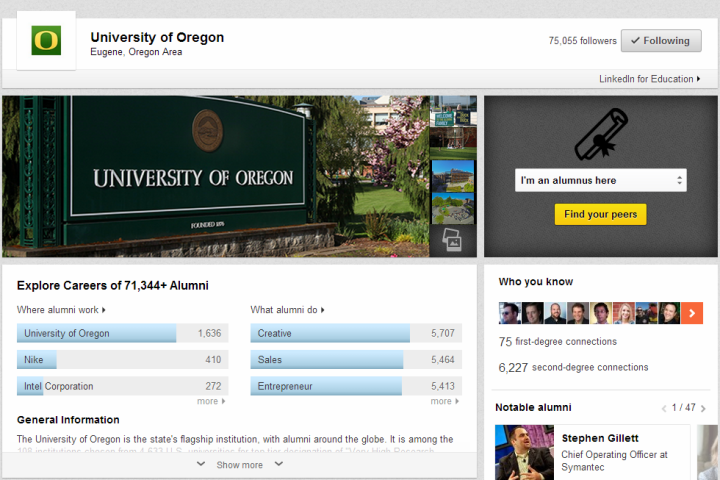
It’s abundantly clear that the tech news cycle very much cares what young people think. While there are certainly a few holes in the theory that teens are an air-tight method of trend forecasting (flippancy; generally horrible taste in most things; lack of foresight; lack of decision-making skills… all of which can be traced back to being 16-something), there’s also no doubt that social platforms are away of the media lure these young users and their digital loyalty bring them.
So it stands to reason that if you’re a network with a minimum age requirement, you’re missing out. While LinkedIn wasn’t necessarily adult-only, the fact that it revolved entirely around your career and professional life cut out a significant demographic. But not anymore: Today LinkedIn announced University Pages to court college students.
“We believe University Pages will be especially valuable for students making their first, big decision about where to attend college,” LinkedIn says. “Therefore, beginning on September 12, we will be making LinkedIn available to high school students who can use LinkedIn to explore schools worldwide, greatly expand their understanding of the careers available, and get a head start on building a network of family and friends to help guide them at every milestone.”
Alongside this announcement, LinkedIn also points out that it’s updated the minimum age requirements: In the U.S., Canada, Germany, Spain, Australia, and South Korea you must be 14. In the Netherlands, 16; China, 18; and 13 years old everywhere else. Prior to today, you had to be 18 to use LinkedIn. It’s worth noting that there are new privacy settings for the teenagers that are about to join the site.
But now the gates have been opened wide – and while it means the younger among us will certainly start using the site, don’t expect the great Tumblrization of LinkedIn to begin. It’s still buttoned-up compared to the “social-only” networks. The 14 year olds signing up for a LinkedIn profile are, assumedly, doing so to start some (way too early, in my opinion) college and career prep – not to share Breaking Bad GIFs and troll their peers.
Of course you can never account for how a user base will interpret and affect a platform. One near certainty? Young, driven users will be ready to hit up their schools’ alumni for advice or connections. Prepare yourselves for the onslaught of advice-seeking suck ups who want an in (and then get off your high horse and remember how desperate we all were for jobs when graduation and loan repayments were looming).
One other implication of the LinkedIn university pages is how they will challenge colleges’ Facebook presence. LinkedIn university pages include standard info, but data like gender breakdowns, tuition costs, student-to-faculty ratios, and graduation rates – as well as the previously mentioned ties to alumni using the platform. It’s much more detailed than what schools can provide on Facebook, and students more and more are using social apps to get an idea of what student life is like. “Overall, according to the survey, 66 percent of prospective college students said that schools should have a social media presence, and 45 percent noted that they have been influenced by a school’s engagement on these platforms,” says the U.S. News and World Report.
Another source of student body revelations? Confession pages and Twitter handles – although prefer to keep things on the less inflammatory side, LinkedIn pages might be a better bet.
